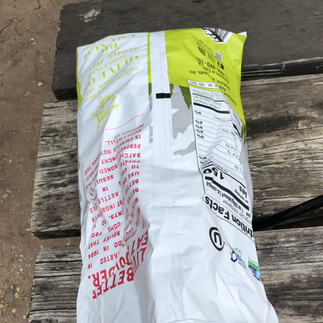The Goal
My goal is to track of my own all single use plastic interactions. Some will be missed due to carelessness. Some will be missed because I am not the one directly using them (e.g. someone else washed the dishes so I didn't get a photo of the soap). Some will be missed because it would be SUPER AWKWARD to pull out my phone and take a photo.
What is a Single Use Plastic Anyway?
Although it sounds intuitive when you first hear it, the line between single use plastic and durable plastic quickly becomes blurry in practice. Some "single use" plastic products aren't thrown away immediately, such as shampoo bottles, toothbrushes, and lighters.
For the purpose of this challenge, I'm counting things that are intended to be disposed of after a finite number uses (e.g. toothbrush, lighter) or which are not intended to serve a purpose after their contents has been emptied (e.g. packaging).
Total Plastic Waste
I'm tracking whether the plastic product was immediately disposed of to get sense of how many total items ended up in the landfill this month. Buying larger containers and using the contents more slowly reduces the total amount of plastic in the landfill.
Substitutes
I'm also noting if I can think of plastic free substitutes. They don't have to be reasonable or easy substitutes, but if I can think of an alternative other than "don't do it at all" I'll list it. I'm defining substitute very narrowly in this context. For example, given that I want to go out to eat at a specific restaurant, is there a way to avoid single use plastic? A substitute might be dining in the restaurant instead of getting takeout. Cooking at home is not a substitute in this context because I can't cook that restaurant's food the same way they do.
Cost is not a factor in whether something can be considered a substitute. Consider my toothpaste. I can buy toothpaste that meets my needs and doesn't use any plastic packaging, but it's expensive. That does count as a substitute.
You may feel that some of the substitutes I list are unreasonably expensive or hard to use or socially awkward or obnoxious in some way. I would generally agree with you and that's why I used the single use plastic!
Reduce & Reuse
The slogan Reduce, Reuse, Recycle is in order of most preferred to least preferred. Reducing your use of single use plastics by avoiding them is considered the best approach. The next best thing is reusing your plastics as many times as feasible, such as reusing a tub of sour cream to keep leftovers in.
As a last resort, recycling is better than sending things to the landfill, but it's a fraught topic. Many people don't recycle correctly, which means that a lot of recycling is spoiled and ends up in the landfill anyway. Even with a perfect batch of recyclables, sometimes nobody wants to do the actual recycling, and things still end up in the landfill. Finally, plastics degrade the more times they're recycled, so even when implemented perfectly it's not a sustainable solution.
I'm giving myself credit when I reuse a single use plastic for a new purpose. This doesn't mean using the same bottle of shampoo for 3 months, but does include things like keeping an empty container and reusing it for leftovers.
These interactions are going to be harder to track because some things are so ingrained as habits that I don't think about how it's reducing my plastic consumption. And sometimes avoiding the plastic altogether is hard to document. How do you take a photo of "not getting takeout"? But I'll highlight some items/strategies that I think of.
Saturday, July 2 (Camping)
This was the first day of my challenge so I probably missed a few items.
Single Use Plastics
Total items disposed of: 5
Total items used: 18
Total items with substitutes: 8
Item | Quantity | Disposed of immediately? | Were there plastic-free substitutes? |
Toothbrush (used twice) | 1 | No | Yes. Bamboo toothbrush. |
Toothpaste (used twice) | 1 | No | Yes. toothpaste tablets, $8 for one month supply |
Coffee Creamer (2 servings) | 2 | Yes - landfill | In context of a restaurant, no. |
Cat's iron supplement | 1 | No | No |
Syringe for cat's iron supplement | 1 | No | Technically yes (reuse existing syringe), but the vet gives you the syringe with the dosage marked on it. |
Cat food packaging - specialty diet | 1 | No | No. The senior cat needs specialty food. |
Cat food packaging - non-specialty diet (not pictured) | 1 | No | Yes. Canned food or cooked human food (e.g. chicken or tuna). |
Hot dog bun packaging | 1 | Yes - landfill | Yes. Home baked buns or buns from a bakery that doesn't bag in plastic. |
Ketchup | 1 | No | Yes. Gallon sized metal container of ketchup from the catering section. |
Mustard | 1 | No | No |
Potato chip bag | 1 | No | No |
M&M bag | 1 | No | No |
Plastic ziplock bags for storage | 4 | Two were disposed of - landfill | Yes. Durable plastic containers. |
Large garbage bag | 1 | No | Yes, bag garbage in paper bags. |
Reduce & Reuse Highlights
We reused plastic takeout containers for leftovers while camping (see photo of hot dog buns and condiments).
We use metal plates and silverware while camping instead of paper plates and plastic forks/knives/spoons.
We use reusable water bottles while camping and fill a large jug with water from home to avoid bottled water.
The scoop we use for cat food originally came from a protein powder mix.



















コメント